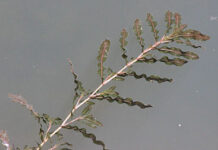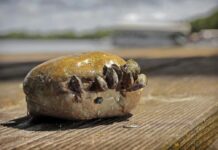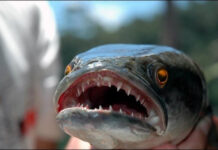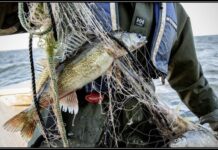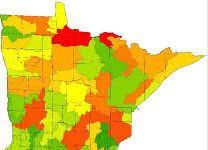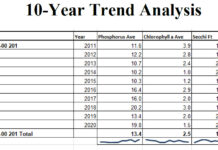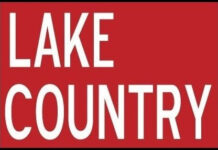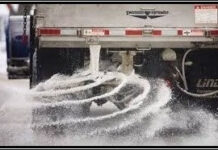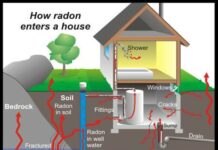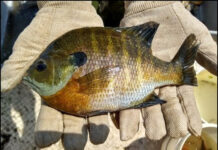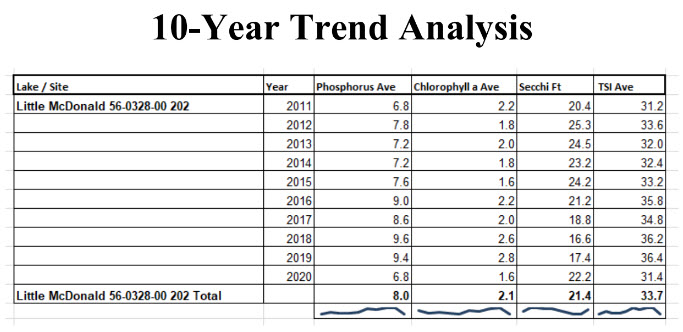Water quality monitoring and the resulting data may appear complex to lake property owners. The science is solid but includes many components that are either difficult for people to understand or that may appear to be inconsistent. It seems that what people really want to know is “Why is my lake so mucky” or “why are there so many weeds in my lake”.
Help in gaining insight to the subject is considering why people are attracted to living at the lake, what makes lakes unique from one another and how result data can be packaged to be used as a tool to assist in constructing actionable policies and practices.
People are not unanimous in their perception of what makes a lake desirable.
Recreation
Some view lakes as opportunities as a source for water recreation. They enjoy swimming, boating and kayaking. For this purpose water cleanliness and clarity are perceived as the most important attributes in determining their opinions of lake health.
Fishing
One of the most popular sports at the lake is fishing. Ardent fishers are less concerned with clarity and more interested in lakes sustaining ecosystems providing ample numbers of sport fish.
Relaxation
Lakes can provide an environment for relaxation. The ambience provided by a natural change of scenery is appreciated by many. They can escape from the challenges and hustle and bustle of every-day living. There is normally less traffic to deal with and also the opportunity to get closer to wildlife and nature.
7 Reasons People Love Lake Living
Lakes are not all the same.
There are many factors that differentiate lakes from one another. The geographic location will influence geology, topography and climate. Sewage control, agriculture run-off, mining and other human practices will affect lakes. Inlets, outlets, lake size and depths will also contribute to the uniqueness of lakes.
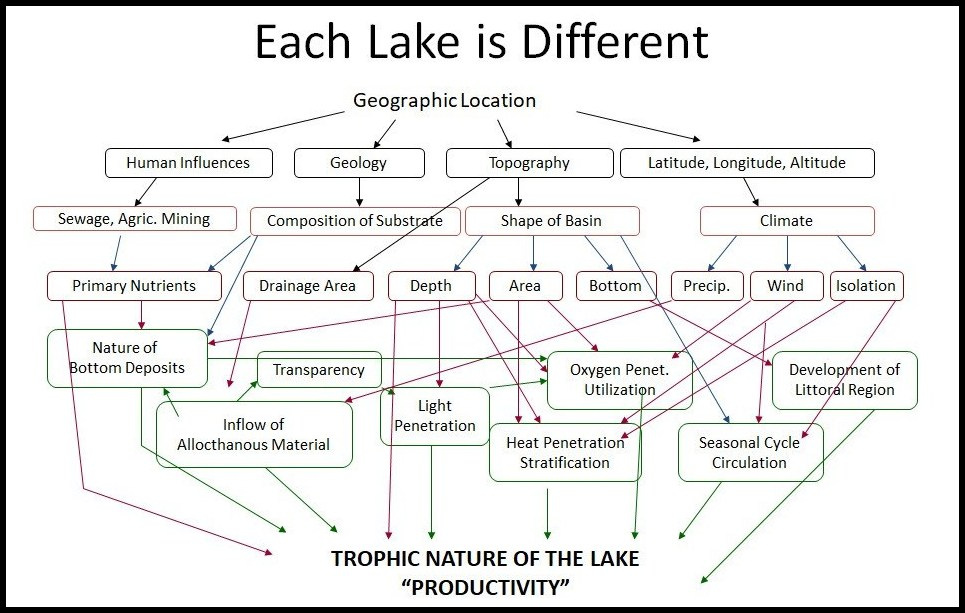
So what is a healthy lake?
A healthy lake is most often described as one whose physical, biological and chemical properties are in equilibrium. This balance provides stability that allows native aquatic organisms to flourish. Because each lake is different, it is difficult to compare lakes to each other. It is best to compare your own lake to itself over time. While it may be obvious when a lake is polluted or impaired, how can you determine if one is in balance?
Lake Monitoring
Three basic lake monitoring measurements are recognized as significant indicators of lake health. They are Total Phosphorus, Chlorophyll-a and Water clarity (secchi depth). These combine together to determine a Trophic State Index (TSI)
- Phosphorus
Phosphorus is a nutrient important for plant growth. In most lakes, phosphorus is the limiting nutrient, which means that everything that plants and algae need to grow is available in excess (sunlight, warmth, water, nitrogen, etc.) except phosphorus. This means that phosphorus has a direct effect on plant and algal growth in lakes – the more phosphorus is available, the more plants and algae there are in the lake. Phosphorus originates from a variety of sources, many of which are related to human activities. Major sources include human and animal wastes, soil erosion, detergents, septic systems and runoff from farmland or fertilized lawns. - Chlorophyll-a
Chlorophyll-a is the pigment that makes plants and algae green. This pigment is what allows plants and algae to photosynthesize. In photosynthesis, plants use the sun’s energy to convert carbon dioxide and water into oxygen and cellular material. - Secchi Depth
Transparency is how easily light can pass through a substance. In lakes this means how deep sunlight penetrates through the water. Plants and algae need sunlight to grow, so they are only able to grow in areas of lakes where the sun penetrates. The top section of the lake that sunlight penetrates is called the Euphotic zone. The area around the edge of the lake that is shallow enough for plants to receive light is called the littoral zone. The area of the lake that is too deep for plants to grow is called the limnetic zone. - Trophic State Index
Trophic State Index (TSI) is a standard measure or means for calculating the trophic status or productivity of a lake. More specifically, it is the total weight of living algae (algae biomass) in a waterbody at a specific location and time. Three variables, chlorophyll a, Secchi depth, and total phosphorus, independently estimate algal biomass.
Phosphorus, Chlorophyll-a (algae concentration) and Secchi depth are related. When phosphorus increases, that means there is more food available for algae, so algal concentrations increase. When algal concentrations increase, the water becomes less transparent and the Secchi depth decreases.
It is important to remember that lake trophic state is not interchangeable with water quality. Water quality is subjective and depends on how you intend to use the waterbody. A lake that is good for duck hunting is not necessarily good for water skiing. In turn, a lake that is great for swimming may not be great for bass fishing.
Lake Monitoring Programs
Coalitions of Lake Associations (COLAs) and other lake organizations sponsor lake monitoring programs in numerous counties in Minnesota. Administration of programs vary but basically volunteers collect phosphorus, chlorophyll-a and secchi samples and measurements five times a season. The samples and measurements are delivered to a laboratory for analysis and recording. The data is posted to be accessed for compilation and reporting.
Uses of the data
Data is one of the components of a Successful Lake Stewardship Program. The data is used by counties and cities for making decisions on lake management. A Lake Management Plan can rely heavily on lake analysis data. Data is relayed to the Minnesota Department of Natural Resources (MN DNR) and the Minnesota Pollution Control Agency (MPCA) for consideration of creating Lake Management Plans and also for qualification for impairment control assistance or grant applications.
Water Quality Analysis Reports
RMB Laboratories (RMB) in Detroit Lakes Minnesota is used by several COLAs and other organizations in Minnesota for analysis of water samples. RMB is a limnology (the study of the biological, chemical, and physical features of lakes and other bodies of fresh water) laboratory that does the analysis of the samples. Result data is posted on the RMB Lakes Program webpage and is made available for creation of individual reports.
Otter Tail County Coalition Of Lake Associations (OTC COLA) has published Water Quality Analysis Reports since 2017. The design has evolved to not only expose water quality aberrations that may warrant immediate attention but also to show long-term trends spanning multiple years. It nurtures engagement of lake property owners to be aware of the value of lake water quality. The design also recognizes the contribution of the volunteers who collect the samples and promotes the COLA or organization that provides the program. The design has been adopted by multiple COLAs.
See Water Quality Analysis Reports
John Kruse lakehelp2@gmail.com

